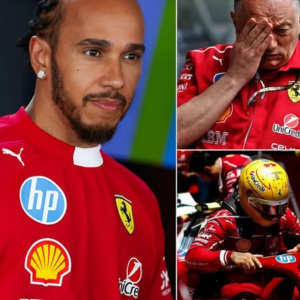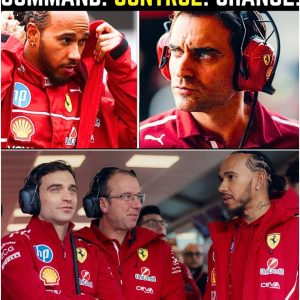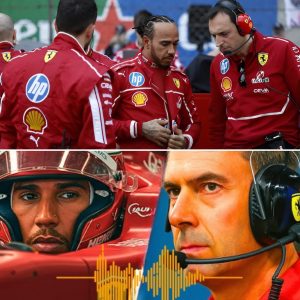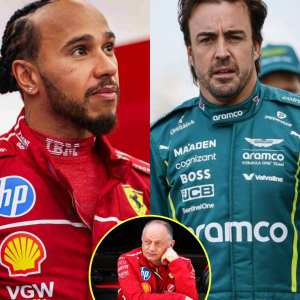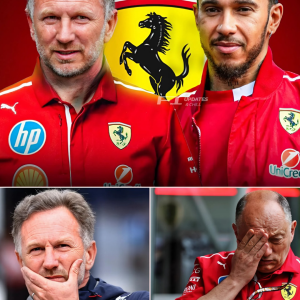At first glance, it looked like just another wet-and-dry Silverstone drama. A seven-time world champion, a tricky car, a gritty fourth-place finish. But listen closer—not to the engine, not to the rain—but to the voice. Calm, clear, unnervingly precise. Lewis Hamilton, post-race, uttered words that shook more than the tarmac beneath his SF-25: “Unbelievably tricky. Very snappy.”
What sounded like technical feedback was far more. It was a warning. A flare shot into the Maranello sky. Not about the car, but the culture.
Hamilton’s commentary wasn’t a complaint. It was a diagnosis. A cry for attention from the man Ferrari brought in not just to drive—but to lead. But when that cry met Fred Vasseur’s shrug and a media-friendly grin, something vital cracked. Not a suspension arm. Trust.
This wasn’t a mechanical failure. It was something deeper, more dangerous. A breakdown of belief.
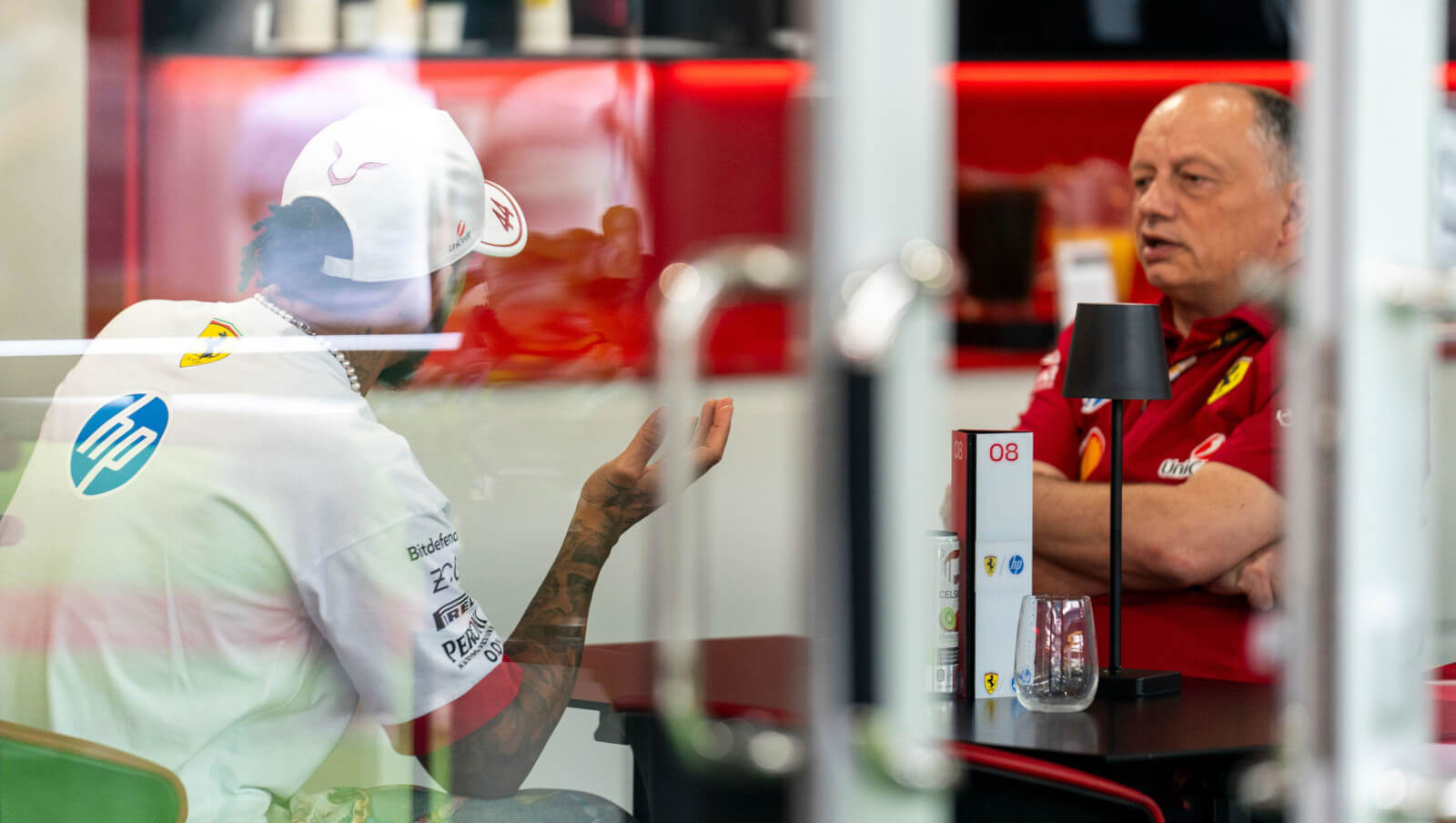
The Numbers Don’t Lie. The Driver Doesn’t Either.
Strip away the headlines and the smirks, and all that remains is brutal data. Onboard footage revealed it all: a Ferrari rear end stepping out under throttle, erratic grip shifts in high-speed corners like Copse and Stowe, and telemetry screaming for help Hamilton never received. Sector by sector, he tamed a car trying to eject him into the grass.
And yet, Vasseur brushed it off. Compared it to Verstappen’s “usual” radio frustrations. As if Hamilton’s voice—one honed through seventeen seasons of feel, instinct, and elite engineering precision—was just noise. Ferrari didn’t investigate. They deflected.
But here’s the problem: in Formula 1, when you ignore the battlefield report from your most experienced soldier, you don’t just lose seconds. You lose direction.
A Cultural Mismatch Brewing in Plain Sight
Hamilton wasn’t hired to be a silent passenger. He was brought in to deliver leadership Ferrari hasn’t seen since the Schumacher-Todt-Brawn days. A vision-driven competitor steeped in the rich, brutally honest world of Mercedes development philosophy.
But Maranello isn’t Mercedes.
Ferrari’s strength has always come with a weakness—its resistance to change. Its reluctance to challenge internal comfort zones. It’s the same pattern that saw Alain Prost labeled a troublemaker, Sebastian Vettel slowly pushed out, and Fernando Alonso left muttering about pit wall chaos.
Hamilton knew Ferrari’s history. But what happened at Silverstone proved that history may be repeating itself.

One Weekend, One Warning
Silverstone 2025 was supposed to be a breakthrough. Instead, it was a reckoning.
Charles Leclerc’s race? Over after the formation lap. A reckless tire call turned his weekend into a test session. Hamilton’s P4 wasn’t just a recovery—it was a rescue mission. Without it, Ferrari may have left their spiritual home with zero points.
And yet, instead of debriefing with urgency, Ferrari’s team boss admitted—on record—that he hadn’t spoken to Hamilton after the race. Let that sink in. A new driver, fresh from dragging an unstable car to the brink of a podium, left unheard. Not because he lacked insight. But because his insight was inconvenient.
The Danger of Denial
Development in F1 isn’t just about wind tunnels and simulation tools. It’s about feedback loops. Listening. Integrating. Trusting.
When a team dismisses elite-level feedback as “not always true,” it builds its next car not on insight—but on arrogance.
The SF-26, already in early development stages, is at risk. Because every ignored voice today becomes a design flaw tomorrow. If Hamilton’s sharp, disruptive feedback is sidelined in favor of legacy comfort, Ferrari isn’t evolving. It’s insulating.
A Warning from the Past
Ferrari’s archives are filled with brilliance undone by mistrust. Prost, Vettel, Alonso—each pushed, each resisted, each left.
Hamilton could be different. He should be. Because he didn’t come chasing the Ferrari dream. He came to redefine it.
But if Maranello keeps recoiling from pressure, dismissing truth-tellers, and choosing quiet over clarity, they won’t just lose performance. They’ll lose purpose.

The Crossroads
Hamilton doesn’t whisper. He warns. His feedback isn’t a suggestion. It’s the distilled essence of two decades at the frontlines of racing evolution.
And yet, Ferrari’s reaction at Silverstone wasn’t to listen. It was to smile. To dodge. To delay.
The question now is simple: will Ferrari evolve with Hamilton—or will it crumble trying to contain him?
Because one thing is clear: the SF-26 is no longer just being built in the simulator. It’s being built in the boardrooms, in the garages, in the backchannels between trust and deflection.
And right now, that foundation is cracking.
Conclusion: Not Just a Race. A Reckoning.
Hamilton’s voice, calm but cutting, isn’t just shaping Ferrari’s present. It’s forecasting its future. Silverstone wasn’t about the weather or the tire call or the balance shift. It was about a truth too uncomfortable for Ferrari to face head-on.
If they ignore it, they won’t just lose 2025. They’ll lose the very thing they sought when they signed Lewis Hamilton: a culture shift. A chance to stop being defined by potential and start being driven by purpose.
Because in Formula 1, belief is everything. And at Silverstone, Hamilton believed in the truth. Ferrari believed in the lie.
And that difference, more than any lap time, may define the next era.
Full Video:

